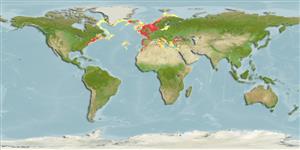Actinoptérygiens (poissons à nageoires rayonnées) >
Perciformes (Perch-likes) >
Scombridae (Mackerels, tunas, bonitos) > Scombrinae
Etymology: Scomber: Greek, skombros = tunny or mackerel, 1623 (Ref. 45335). More on author: Linnaeus.
Environnement / Climat / Gamme
Écologie
; marin; saumâtre; océanodrome (Ref. 51243); profondeur 0 - 1000 m (Ref. 54254), usually 0 - 200 m (Ref. 54254). Temperate, preferred 10°C (Ref. 107945); 70°N - 25°N, 77°W - 42°E
North Atlantic: including the Mediterranean.
Length at first maturity / Taille / Poids / Âge
Maturity: Lm 28.7, range 34 - ? cm
Max length : 60.0 cm FL mâle / non sexé; (Ref. 35388); common length : 30.0 cm FL mâle / non sexé; (Ref. 168); poids max. publié: 3.4 kg (Ref. 9988); âge max. reporté: 17 années (Ref. 207)
Épines dorsales (Total): 8 - 14; Rayons mous dorsaux (Total): 113; Épines anales 1; Rayons mous anaux: 12 - 13; Vertèbres: 31. This species has the following characters: no well developed corselet; interpelvic process small and single; anal fin spine conspicuous, joined to the fin by a membrane but clearly independent of it; anal fin origin opposite that of second dorsal fin; no swim bladder; first haemal spine anterior to first interneural process; 21-28 interneural bones under first dorsal fin; markings on back oblique to near vertical, with relatively little undulating; belly unmarked (Ref. 168).
Abundant in cold and temperate shelf areas, forms large schools near the surface. They overwinter in deeper waters but move closer to shore in spring when water temperatures range between 11° and 14°C. Mainly diurnal, it feeds on zooplankton and small fish. Eggs and larvae are pelagic (Ref. 6769). Batch spawner (Ref. 51846). The species is traded fresh, frozen, smoked and canned. Eaten fried, broiled and baked (Ref. 9988). Two stocks in north-east Atlantic: North Sea (east) and British Isles (west). North Sea stock decreased dramatically in the 1960's because of direct overfishing. Recruitment has been poor and unstable. After spawning, the adult feed very actively moving around in small shoals (Ref. 35388).
Collette, B.B. and C.E. Nauen, 1983. FAO Species Catalogue. Vol. 2. Scombrids of the world. An annotated and illustrated catalogue of tunas, mackerels, bonitos and related species known to date. Rome: FAO. FAO Fish. Synop. 125(2):137 p. (Ref. 168)
Statut dans la liste rouge de l'IUCN (Ref. 115185)
CITES (Ref. 94142)
Not Evaluated
Menace pour l'homme
Harmless
Utilisations par l'homme
Pêcheries: hautement commercial; pêche sportive: oui
Outils
Articles particuliers
Télécharger en XML
Sources Internet
Estimates of some properties based on models
Phylogenetic diversity index (Ref.
82805): PD
50 = 0.5625 [Uniqueness, from 0.5 = low to 2.0 = high].
Bayesian length-weight: a=0.00603 (0.00540 - 0.00673), b=3.07 (3.04 - 3.10), in cm Total Length, based on LWR estimates for this species (Ref.
93245).
Niveau trophique (Ref.
69278): 3.6 ±0.2 se; Based on diet studies.
Résilience (Ref.
69278): Milieu, temps minimum de doublement de population : 1,4 à 4,4 années (rm=0.33-0.56; K=0.23-0.27; tm=2-3; tmax=17; Fec=200,000).
Prior r = 0.48, 2 SD range = 0.23 - 1.00, log(r) = -0.73, SD log(r) = 0.37, Based on: 1 M, 16 K, 13 tgen, 1 tmax, 25 Fec records
Vulnérabilité (Ref.
59153): Moderate vulnerability (44 of 100) .
